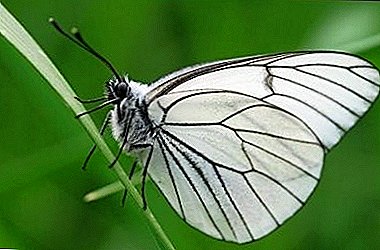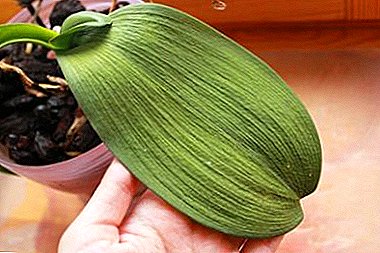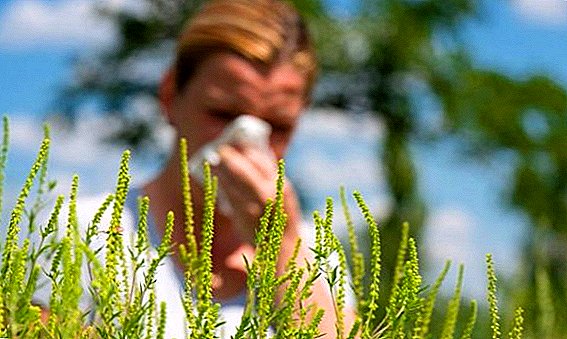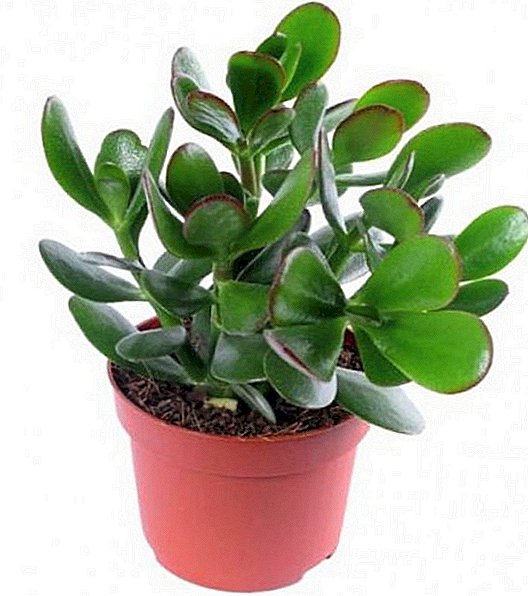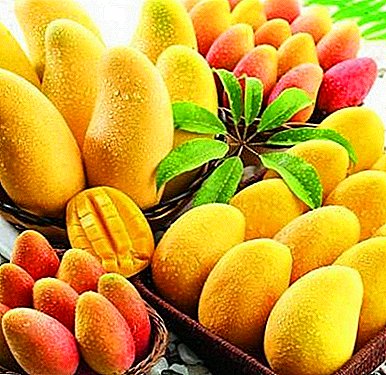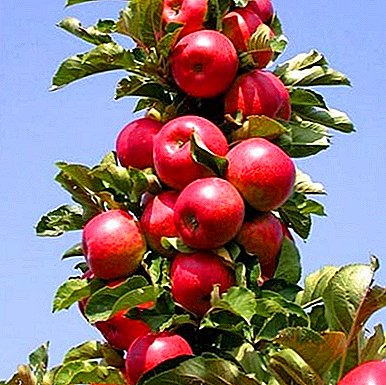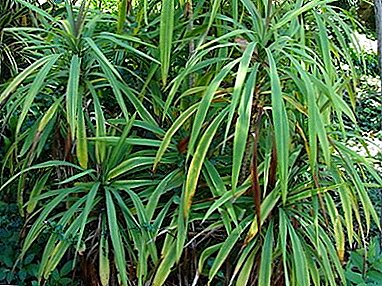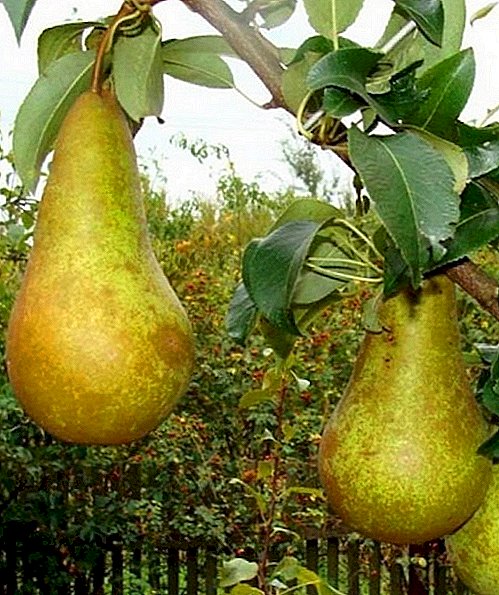 Pear is one of the most common fruit trees, and pear fruits are used both for fresh consumption and for making jam, compotes, dried fruits and other delicious desserts.
Pear is one of the most common fruit trees, and pear fruits are used both for fresh consumption and for making jam, compotes, dried fruits and other delicious desserts.
In addition to excellent taste, pear also has a high content of nutrients, so in each garden should grow at least one pear tree.
In this article we will talk about pear "Conference", consider the description of the variety, the benefits and harm of the fruit, as well as the characteristics of planting and caring for the plant.
Breeding history
Pear "Conference" refers to the English breeding variety. It is believed that this variety was the result of free pollination "Deon Leclerc de Laval" in the 2nd half of the XIX century.
The year 1895 is celebrated when the British National Conference on the cultivation of pears was held. It was there that this variety was marked, and thanks to this event the pear got its name.
Description and distinctive features of the variety
"Conference" is a popular autumn variety and has distinctive features that distinguish it from other varieties of pears, therefore, we will consider a detailed description of trees and fruits. 
Wood
Trees varieties have an average power of growth or differ in strength. The tree has a thick, wide, pyramidal crown, which is well leafy.
An adult tree reaches a height of at least 5 meters. The leafy part of the plant is characterized by smooth, shiny leafy plates.
In the spring, the leaves are distinguished by a light-green tinge, and closer to the autumn - they get in dark green tones. The tree blooms in early spring, the inflorescences are collected in small groups. Blossom has a white and pink shade and smells great. 
Fruits
Fruits of a pear differ in the large size, juiciness and sweet taste. One pear weighs about 150 g on average. The fruits have an elongated bottle-like shape.
Pears are characterized by a matte, dense, harsh greenish-yellow skin. Often, on fruits that have been under direct sunlight for a long time, reddish spots form on one side.
Check out such varieties of pears as "Century", "Bryansk Beauty", "Honey", "Rossoshanskaya dessert", "Hera", "Krasulya", "Otradnenskaya", "Rogneda", "Fairytale", "Duchess", " Lada. "The flesh has a yellow, creamy or slightly pink color, an oily structure, excellent aroma and fine graininess.
Pear "Conference" is not only a tasty fruit, but also very useful. It is rich in citric, malic, oxalic acid, which normalize digestive processes. It contains vitamins A, B, C. The fruits are also rich in iodine, potassium, calcium, magnesium, copper, phosphorus, iron and zinc.  The fruit contains a large amount of fructose and is low in glucose and low in calories, so the Conference is recommended to use a pear during the period of dysfunction of the pancreas, with obesity and diabetes.
The fruit contains a large amount of fructose and is low in glucose and low in calories, so the Conference is recommended to use a pear during the period of dysfunction of the pancreas, with obesity and diabetes.
Fruits have a beneficial effect on the functioning of the heart due to the increased content of potassium.
Did you know? Seafarers from ancient Greece used a pear during a long voyage, considering it a cure for seasickness.Due to the increased content of organic acids, the processes of digestion, metabolism, stimulation of the activity of the liver and kidneys improve.
With regard to harm in use, it is almost none, the main thing is to take into account the peculiarities of your body and not to consume more than 2 pears per day.
It is categorically not recommended to use raw fruits in case of a disease of the gastrointestinal tract, especially with a stomach ulcer.  Irritation of the intestinal mucosa may occur if the fasting fruit is eaten. It is also forbidden to drink liquid after drinking pears, as this may cause diarrhea and abdominal pain.
Irritation of the intestinal mucosa may occur if the fasting fruit is eaten. It is also forbidden to drink liquid after drinking pears, as this may cause diarrhea and abdominal pain.
Advantages and disadvantages
"Conference", undoubtedly, occupies a leading position in the list of consumed varieties, but consider in more detail all the pros and cons.
pros
The main advantages of the variety are that:
- Pear begins early, abundantly and regularly bear fruit after planting seedlings, of course, if you follow all the rules for caring for the plant.
- Ability to self-pollination. She does not need pollinating varieties in the neighborhood. The main advantage of self-pollination is the fact that pollen is quite viable in 80% of cases. Thanks to this feature, gardeners who do not have a large area to create a garden can only plant one pear. If your territory is large, the “Conference” will be an excellent pollinator for other varieties. Nearby recommend planting "Hoverla", "Striyskaya", "Kucheryanka".
- Thanks to the excellent taste of fruit, pears are planted not only for home consumption, but also on farms, on an industrial scale.

Minuses
But, despite all the advantages of the considered variety, there are still some drawbacks, among them are:
- Relatively poor winter hardiness. If the air temperature drops to minus 22 degrees - the tree will not survive.
- Influence of weather on fruiting. If the weather is cloudy, cold, rainy and windy in the summer, the fruits may not ripen or the taste will suffer greatly.
Important! The best condition is considered to be sunny weather, only in this case the proper ripening of the fruits will occur.
- Poor tolerates the effects of fungi, being exposed to the development of various diseases.

How to choose the seedlings
In order to choose a quality seedling, you must follow some rules:
- Well examine the seedling. It must be healthy, intact, fresh in appearance. It must contain a tag with the breeder of the variety and the recommended growing area.
- In the event that the roots of the seedling are open and do not have an earthen coma, which can sometimes mask the damaged or dried root system, you should carefully inspect the planting material on the integrity of the roots. The root system of a healthy pear is light, both outside and on the cut, does not have any spots or growths.
- Young trees, no more than 2 years old, are recommended for purchase.
- Annual trees do not have crowns; if you purchase older plants, it is recommended to choose specimens that will have evenly distributed shoots.
Choosing a place on the site
The key to good seedling development is the right place for planting. The soil on which the pears will be planted should be looseness and lightness, but with the ability to retain moisture.  The acid-base balance of the soil should be neutral or slightly alkaline. The best option is considered to be loose loam, forest sierozem or black soil, not suitable for planting: light sandy or sandy sandy soils, heavy clay, peaty, silty soils.
The acid-base balance of the soil should be neutral or slightly alkaline. The best option is considered to be loose loam, forest sierozem or black soil, not suitable for planting: light sandy or sandy sandy soils, heavy clay, peaty, silty soils.
The normal development of the soil depends very much on the amount of sunlight, heat and fresh air, therefore it is necessary to select the areas for pear planting that meet these criteria.
It is also necessary to take into account that the tree does not tolerate strong gusts of wind, as in the winter period the plant may freeze, and in the spring and summer - the loss of flowers, ovaries and fruits.
It is not recommended to plant a pear in the lowlands, because excessive proximity to groundwater can have a negative effect on the tree and manifest itself in the form of rotting of the roots.
Considering that the tree will grow tall with a wide crown, it is necessary to plant it away from other perennial crops. If two pears are planned to be planted nearby, then keep a distance of at least 5 m between them.
If there is a wall near the pear, a crown may form incorrectly, which will worsen the fruiting or provoke its absence. 
Important! Next to a rowan tree, a pear can be more often exposed to diseases and pests, since they suffer from the same diseases, and therefore can constantly become infected from each other.
Pre-work
If you live in a marshy area, before planting a pear should take care of the cultivation of the planting area.
First, one should pick up the most elevated place and dig out small ditches along the perimeter of the territory, take them to the very lowland, which is located behind the garden so that excess water flows there.
Then take care of the drainage shafts on which the pears will be planted. As a drainage, you can resort to the use of stumps, trunks, branches, mowed grass, fallen leaves or household garbage.
Initially, the territory is filled with drainage, the largest and slowly rotting parts are gradually laid down, smaller and organic parts are laid on top.
Drainage is filled with soil that has been previously excavated from the trench. Recommends to carry out the procedure in the autumn, so that during the winter the ramparts are settled and they can be landed.  Pits for planting seedlings need to be prepared in advance, if planting will be done in the spring, then you need to dig a hole in the fall, and if in the fall, then a month before planting.
Pits for planting seedlings need to be prepared in advance, if planting will be done in the spring, then you need to dig a hole in the fall, and if in the fall, then a month before planting.
Trees of a strong-growing stock should be planted in pits with a width of one and a half meters and a depth of 1 m. A dwarf pear on a quince needs a pit that is 90 cm wide and 80 cm deep.
Learn how to plant a pear.
Step-by-step process of planting seedlings
Consider the detailed step by step instructions on how to plant a seedling in a prepared pit:
- The first thing you need to prepare a solid support, which will be fixed in the pit in order to then tie up the sapling.
- At the bottom of the pit, a pre-prepared mixture of soil is poured, into which the rotted organic matter is added, in the form of compost or humus, before the formation of a hill.
- A sapling is installed on the hill, while the root neck is not changed.
- Next, you need to gently straighten the roots and fill the pit with soil that is mixed with organic matter.
- The soil around the trunk is compacted to prevent the presence of voids at the roots.
- After planting, it is necessary to water a sapling well, in the amount of three buckets of water per tree.
- Further recommended to mulch the soil with sawdust or straw.
- The last procedure is a garter sapling to support.
Seasonal care features
In order for a pear to bear fruit well and develop normally, it needs to provide proper care.
Soil care
In order for a pear to feel good in a new place, it is necessary to carry out timely watering of the plant - the quality and quantity of fruits, as well as the growth rate of the tree, directly depend on them.
Watering is necessary depending on weather conditions, soil type and age of the pear. If the summer is dry - watering should be especially careful, at least once a week for two or three buckets under each tree.
In the spring, it is necessary to take special care of loosening the land and weeding, so that they do not harm the root system, especially young seedlings.
To loosen the ground, it is recommended to dig up the trunk circle and loosen the breast with a rake. In the autumn, in order to protect the roots from freezing, it is necessary to produce a mulching of the trunk circle in a sufficiently thick layer.  As mulch is recommended to use sawdust, foliage from trees or straw. Pour the mulch should be after the soil is dug up and made dressing.
As mulch is recommended to use sawdust, foliage from trees or straw. Pour the mulch should be after the soil is dug up and made dressing.
Top dressing
Pear is a plant that needs a high content of humus in the soil. During the spring digging period, it is necessary to deposit about 4 buckets of humus under one tree, considering its age and size.
If there is a shortage of organic substances, it is necessary to add about 30 g of ammonium nitrate, and during the autumn digging period, potassium sulphate in an amount of 30 g and superphosphate in an amount of 50 g are added.
Important! It is not recommended to add nitrogen in the autumn period, as it is possible to provoke the deterioration of wintering and create barriers for the normal maturation of the shoots.
It should also be borne in mind that if you apply mineral fertilizers in higher quantities, the fruits will be poorly stored and can be harmful to health. 
Preventive spraying
In order to prevent enterobiosis or brown spot, it is necessary to remove the plant residues in the plant's surrounding circle and burn them.
For the same purpose it is necessary to produce deep loosening and digging up of the soil in the autumn and spring period. The “Conference” will be more resistant to brown spot if potash phosphate mineral fertilizers are applied annually.
In the autumn period, Nitrophoska can be recommended for this. If the first signs of enterobiasis appear, which appear as small gray-brown concave spots with a black dot, spraying with Bordeaux liquid should be performed immediately.
The first treatment is carried out in April, for this Bordeaux liquid in an amount of 30 ml is diluted in 10 liters of water.
The second time processing is carried out after the plant has faded, the concentration of the drug is reduced by 3 times. The third treatment is made at the end of the month after the previous one. For the prevention of white spot or septoria, it is necessary to produce Nitrafen treatment in the spring and autumn period, using 100 g of product per 10 liters of water.
To prevent the development of black cancer, which manifests itself in the form of black spots and rot on the branches, fruits and stem, it is necessary to produce autumn processing of the trunk and the main branches with lime milk, in which to add copper sulphate at the rate of 100 g of the product per 10 l of lime mixture.
So that the pear does not hit the pearpod, it is necessary a couple of days before the tree blooms and immediately after flowering to spray with Agravertin.
After a month, spraying should be repeated, but using Kinmiks. After 30 days the spraying is repeated, Spark-Bio is used.
Against a pear sucker it is possible to process a pear before flowering with a 3% solution of Karbofos, after flowering the tree is processed with Iskra-Bio or Agravertin.  From the leafworm, the pear is processed in the spring, when the night temperature will prevail above zero. At this time, it is necessary to process the tree "Tsimbush".
From the leafworm, the pear is processed in the spring, when the night temperature will prevail above zero. At this time, it is necessary to process the tree "Tsimbush".
Cropping and crown formation
Another important element in pear care is regular pruning and crown formation. The procedure is carried out in the spring, at a time when the thermometer will show a positive temperature at night.
It is important to have time to prune before the time when active budding begins..
You will probably be interested to learn how to properly trim the pear in the spring.The shape of the crown, which you will attach to the tree, you can choose yourself, it can be:
- Palmette - the type of crown, which is minimal intervention in the growth of the tree. Each year it is necessary to cut the main branch - the conductor to 30 cm, also thin out the thickened crown and remove the affected and dried branches.
- Sparse-tiered form at which the conductor is pruned slightly higher than the side shoots grow, and a new tier of 4 skeletal branches is formed. The branches that grow down, as well as the shoots, are cut off completely. Shoots that grow up, shortened by the 1st or 2nd sheet.
 Both in the first and in the second case it is necessary to cut vertically growing shoots - tops, which thicken the crown, but do not bear fruit.
Both in the first and in the second case it is necessary to cut vertically growing shoots - tops, which thicken the crown, but do not bear fruit.Did you know? In European countries, pear came from South Asia, the approximate time - 1 thousand years BC. er Later, all pears could feast on in North America, where the pear was brought only in 1620.
Protection against cold and rodents
In late autumn, you need to build a tree shelter for a normal wintering. Especially hard to survive the cold winters young saplings.
To protect young plants from frost and rodents, they are recommended to be tied with coniferous branches and a covering material that is well breathable.
In early spring, shelter should be removed in order to prevent bark heating during the thaw period, which can cause the death of the plant.
Thus, the pear Conference is a heat-loving variety and is recommended for planting in regions with mild southern winters.  It is rather simple to care for a plant, the main thing is to carry out tree pruning in time, to make dressing, watering and spraying to get a large and high-quality crop.
It is rather simple to care for a plant, the main thing is to carry out tree pruning in time, to make dressing, watering and spraying to get a large and high-quality crop.


